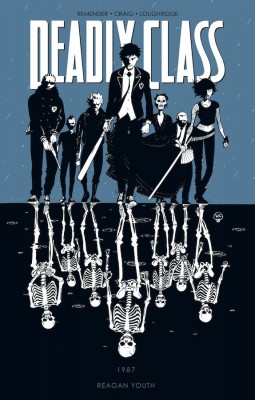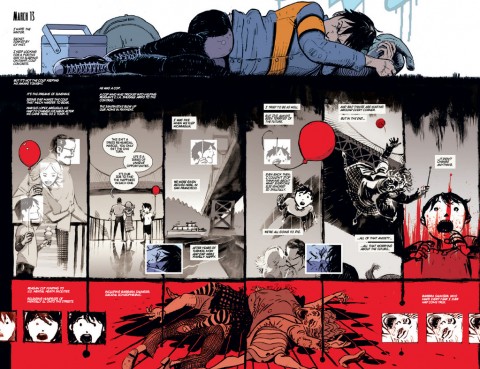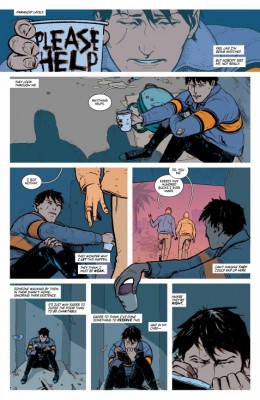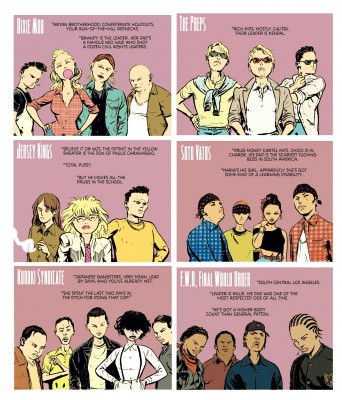A Filipino Reader’s View of the 80s & Rick Remender’s DEADLY CLASS
Viewing Deadly Class in the lens of the Eighty era Reader: Critique, Reflection, Insight
Many view the 80s with awe, but also with misgivings. In my vivid recollections, this decade was the moment of self-awareness of outside happenings that in hindsight, more memorable in the twisted way. At the early consciousness, my parents rooted for change in leadership; the images of “Ninoy” and Corazon “Cory” Aquino were prominent; the “L” hand symbol in contrast to “V” for the Marcos loyalists; the several coup attempts or kudeta that raged the headlines; the wanted posters of Gringo Honasan whose bounty started from one million pesos and peaked on two million pesos; the appearances of tora-tora during those tumultuous times; the power shortages that we endured then; the apex of Philippine action films (and the introduction of Robin Padilla); and some memorable weekend and daily afternoon cartoons like Mask, Visionaries, Inhumanoids, Astro Boy, Voltron, Macross/Robotech, Daimos, Voltes V, Transformers, and G.I. Joe. My consciousness was fully manifested in the 90s but the seeds were already activated then.
Comic reading was limited to horror and suspense genre, to the enjoyable Funny Komiks that were literally everywhere, from marketplace to transportation terminals. So memorable that perhaps made me more appreciative then to the medium’s vast potentialities to make a nation more united, cohesive, meaningful, and the catalyst of change. Speaking of comics, there were many on-going titles in both Marvel Comics and DC Comics; and more prominently, the late 80s marked the transition in comics industry from the so-called Bronze Age to modern era (but rock-comic-god Grant Morrison later in his best-selling work Age of Gods categorized it as the beginning of the “Dark Age”) due to the riveting and game-changing visual masterpieces such as Maus (Art Spigelmann), The Dark Knight Returns (Frank Miller), and The Watchmen (Alan Moore and Dave Gibbons that saw the tone and mood of crafting stories that is still felt up to this day.
From the start, I embraced, loved, and emulated the Batman more than I cared with. Though I saw and enjoyed the campy Adam West-Batman series later on, the Tim Burton-Batman movies, especially the 1989 masterpiece, were the closest things I visualized of the Dark Crusader as my alpha uber-hero. Oh the good times indeed!
The importance of the said decade can be glanced in the same medium due to the reality that both writers and illustrators then stamped their visions, perspectives, critiques, and other marks that defined the era in visual paneling and story-telling approaches, even these were then considered as mere “art-forms” by “serious” (or snotty/myopic) members of the high society. If Maus alone can teach something, Art presented another possibility of recounting/retelling family history with a number of symbolisms that readers could easily grasp. The Dark Knight Returns is Miller’s tongue-in-cheek political and cultural critique on the ongoing Reagan administration and the paranoia surrounding the Cold War. Alan Moore and Dave Gibbons pushed the envelope of visual sophistication in The Watchmen that showed the scenario of the existence of the flawed and damaged superheroes in the 80s. Moreover, Chris Claremont’s soap opera Uncanny X-men run produced social commentaries on racism in the guises of mutants-humans relationship (in addition of his knack of characterizations of numerous protagonists like Wolverine, Cyclops, Jean Grey and Storm for examples). John Byrne, George Perez and Walter Simonson illustrated characters in their respective titles (Fantastic Four, The New Titans and Thor, for instances) that undoubtedly characterized the flavor(s) of the said epoch, particularly women and/or super-heroines. In short, they captured and the essences of the times.
Naturally, many future comic artists and writers also lived the roller-coasting decade, and eventually marked their marks (and authority) in their designated assignments. In addition of the existence of “creator-owned” titles or independent or “indie” comics in the 90s up to the present, some of these top caliber breed of young guns attempt to look back and show their fans and serious comic readers their respective pasts and narrated and visualized (with exaggerations, of course) their memories on the blank canvas. One of these titles is Rick Remender and Wes Craig’s Deadly Class.
Unleashed just last year (2014) by Image Comics, Remender told the audience/readers that his series is more “semi-autobiographical” take on his teenage (and rebellious) tumultuous years, and the experiences he endured/enjoyed/envisioned/eschewed. Together with the equally talented and no-holds barred maestro Craig, the creator set his eyes on the 80s San Francisco and revolved on his “past-mirror-phantasm”—Marcus Lopez, a Nicaraguan immigrant whose life was basically so damaged, filled with typical adolescent rage/anger that simmers whenever that comes. The series is still on-going, already wrapping-up its second volume entitled “Kids of the Black Hole”, while the first volume, “The Reagan Youth” is already available in popular bookstores and comic book shops. This run is even considered as one of the best comics series in 2014 alone, and what’s admirable with Remender is that he writes a number of indie and superhero titles, such as Black Science, Low for Image Comics; and Captain America, Uncanny Avengers and the mega-event (but sadly disappointing) Axis for Marvel; showing critics, readers and fans how dedicated, passionate and determined he is in crafting dark, gritty, ironic, a bit realistic, suspense-filling, and page-turning stories he already mastered since turning to full-time scribe in the 2000s (just read his Thompson-Venom, Uncanny X-Force, and Punisher runs to see the point).
Remender fuses his brand of storytelling, popular cultural references, historical events and backgrounds, and a bit of surrealism in homage of this generation’s most popular fictional school for witchcraft, though “DEADLY” literally and figuratively speaking. He himself is a product of the times. He admitted in the start that he experienced a sense of alienation and a sense of being different due to his diverse background, compounded that his family moved from one city to another in his adolescent years. Furthermore, he witnessed and experienced racial discrimination by being bullied, slurred, fisticuffs, and other matters related to being non-white (and vice-versa). Those personal memories are shown in many dialogues whenever Marcus and other supporting characters talked/thought/interacted/ implied/viewed with themselves or one another. One example that really caught my attention was in issue two when a redneck teenage lady replied Marcus (upon learning his nationality) that whatever races (she mentioned Filipino, among other nationalities), they make no difference whatsoever. However, that sense of alienation/discrimination serves as a conduit of creating new allies/friends of other diverse groups/ nationalities/ethnicities. Also, he must keep an eye or two for possible death for he has a huge and notorious reputation he unwillingly made (or what the local media cooked up then) that made him a big target just the same.
Furthermore, Remender is basically critiquing the Reagan administration by pointing out the flaws the famous (and beloved) president decreed upon. Thus, an amateurish application of critical history is being utilized after all. First, the 80s marked the continuing existence of dictatorships in Latin America that the US government supported them as long as the former combated communist elements or the “Dirty War” in other historical texts. The shadowy intelligence institution, the Central Intelligence Agency (CIA) had a huge hand in manipulating or guiding these dictatorial states as long as these nations served America’s interest. Marcus’s father was a CIA-asset whose services were rewarded in the form of immigration in the so-called Land of the Free with his entire family. But tragedy struck, which led to another of Remender’s punch in Reagan’s face—budget cuts. The American president cut federal funding on many social services, including mental rehabilitations that forced wards to release psychologically-impaired patients to the streets. Marcus’s parents were brutally killed by a suicidal deranged psychopath during a family strolling in the San Francisco Bridge. All of these occurrences take place in the premier issue alone. As explored in the ninth part, he was homeless and first placed under an orphanage that clandestinely operated as a sweatshop, using him and other abandoned children as cheap labor under the abusive and tyrannical and morally hypocritical watch of an elderly woman. Worse, he was caged with the sexually-charged molester who was later the true responsible for the gruesome crime Marcus was mistakenly attributed. And speaking of hypocrisy, in the exploration of Marcus’s love interest Maya, the eighth chapter tackles the usage of religiosity and symbolisms in promoting fear to the downtrodden in her impoverished village, where the criminal warlord had her father being crucified just to serve as a warning for those who wanted to mess with him and his family. This dark moment reflects how the powerful use and abuse Catholic/Christian texts to its personal and socio-economic dominance, further justifying the Marxist adage of religion as the so-called opiate of the masses and one of the components of the super structure. Going back to Marcus’s case, his ultimate dream was to assassinate Reagan himself for the misfortunes befell upon him, what he told his newfound friends in the second part. What a strong statement to the so-called “god” of American politics!
Though Remender grew in the state of Arizona during his adolescent years, it doesn’t mean the cool settings of San Francisco City diminished the power of these chaotic teenagers could do. The run chases in the first issue and other subsequent issues show the artist’s knowledgeable sense of intricacies of the Golden City, including the famous locations and roads that defined the city and the times together. Even the existence of the less fortunate is never left out for they simply existed then, and more so presently. Marcus and some of his acquaintances endured the stark dichotomy of the “have’s” and the “have-not’s” in searching for temporary shelters, conducting petty crimes and experiencing pneumonia due to harsh elements (and lack of basic shelters). Plus, the adventures he and his adventurous friends to Nevada do not hurt the narrative. That moment from the fourth issue to the sixth part actually heightens the readers’ appetite for the twisting plot Remender crafted so well that explains why the series is still being considered worthy to follow until the climatic finish (?).
Of course, what is this sense of teenage rebellion without sex and drugs? I don’t generalize this obvious trapping of human development/moment, but many young readers actually hook this series due to that said connectivity. Though the space that widens the gap between the 80s and the present generations, there are some cultural practices are still looming and being done whenever the opportunity demands or comes upon. Remender and Craig do an excellent job of presenting these vices/rebellious acts without being so visual graphic for the sake of being shockingly graphic. These moments are done with reasons or justifications that are part of the characterizations of the protagonists and antagonists in the story. The shadings during these acts are almost done with great care to direct the readers of releasing their inner desire(s) or angst they possess. What are so memorable here are the psychedelic consequences Marcus did by consuming huge quantities of deadly substances shown in the fourth up to the fifth part without even thinking the outcome (yes, that’s adolescence at its best!). Craig portrayed numerous artistic mumbo jumbos on interpreting Remender’s vision during Marcus’s psychedelic hallucinations (to hilarious effects!), and the writer’s crazy dialogues fit the delusional mayhem Marcus experienced up to Las Vegas, the Sin City! The irony indeed! Those moments lessened in the succeeding issue or the second arc, but the sexual tensions heighten more on our anti-hero to both Maya and Saya to the point of being used as instrument for story development that I can’t wait in future installments.
Then and now, Remender shows us readers how beautifully chaotic in our teenage years, in-and-outside the rooms of secondary schools. I know some of us never experience the ways and moments of our counterparts, particularly Rick’s (if the drugs, violence and sex presented are the main indicators in this semi-autobiography) yet the sense of belongingness and esprit d’corps are strong throughout the series, including their opposites like betrayals and isolation/solitariness that probably makes this “Deadly Class” more connecting, relating, engaging and empowering to both fans and critics alike. We maybe our own masters of destiny, but at the same time, we need allies/comrades/friends to reach our goals, if not getting sympathies for the troubles we make or encountered. Yet, there are pretentious types who already know how to “select” the kind of people they want to be associated for their own ends/agendas. That’s how Remender and Craig convey and illustrate their then human interactions without being too preachy, sarcastic and sugar-coating; but the twisting tones are nevertheless apparent, if not laid down to the eagle-eyed type readers. Thus, the creators remind us the other side of the glorious high school years indeed.
Remender promises readers in the readers’ column in the tenth issue a “happy-ending” to his postmodern biography but his characters must go through the wringer for a couple of issues more, just like what he did in his gut-wrenching stories in Venom, Punisher and The Uncanny X-Force, though more hopefully this send-off would be uplifting and seriously “happy” unlike the abovementioned opuses. Will Marcus overcome the demons festering his heart and soul? Will he find the true lady he wants to share with after the Deadly Class? Will he ever find time to forgive himself and move forward? Or, will he fulfill his “true” calling and let the deadly school of killing and its masters of deadly arts teach him to be such? And, these same questions go to his classmates, enemies and friends as well.
Deadly Class is a study of the roller-coasting, tumultuous and a bit pessimistic decade that was the 80s in the artistic lenses of Remender and Craig. It also cements further since the abovementioned graphic novels greatness how comics as a medium and in independent mode metamorphoses as a serious instrument of visual critique, if not a personal indictment, to the zeitgeists of that time, and at the same time; the creators show us why the misunderstood decade was also the defining moments for them, and even so to the nostalgic readers alike.

























